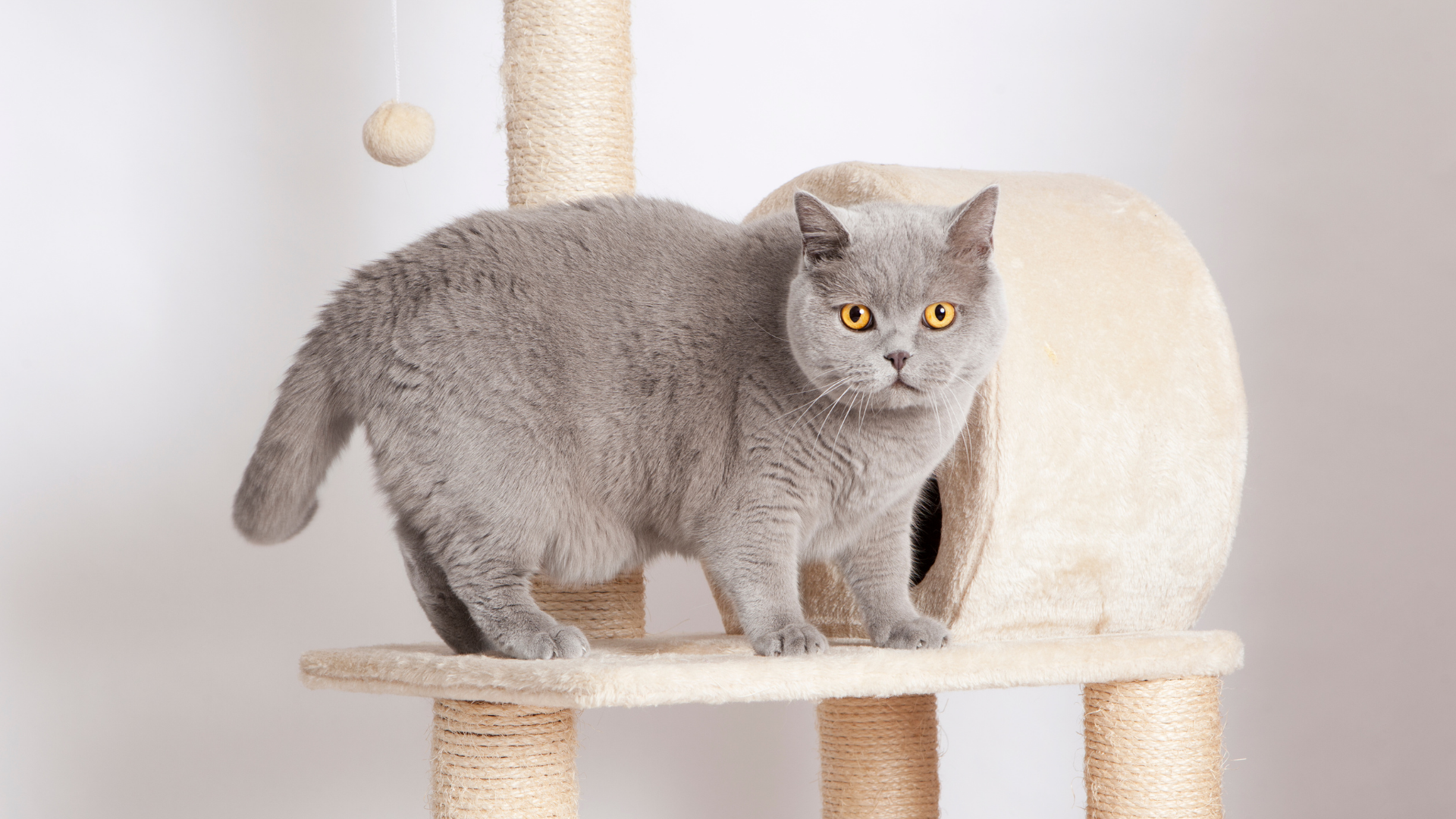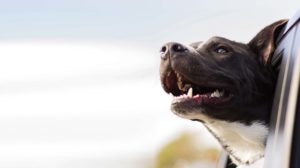British Shorthair | Breed highlights
| Breed: | The British Shorthair is a pedigree, medium-sized cat breed, recognisable for its dense fur, stocky build and rounded face. |
| Coat type: | British Shorthair cats have short coats of plush fur. Some types of British Shorthaired cats may have a double-layered coat. |
| Shedding: | British Shorthair cats shed a moderate amount year-round and will shed more during Autumn and Spring. |
| Grooming: | Regular brushing helps remove any excess or loose fur. |
| Activity level: | Moderate. |
| Apartment friendly: | Yes. |
| Small children: | No. This breed does not like to be picked up. |
| Other pet friendly: | Yes. |
What type of breed is a British Shorthair ?
The British Shorthair is a muscular-bodied cat, recognisable for various distinctive features. These include a dense coat, a broad face, and large round eyes. The British Shorthair comes in different colours and patterns; however, the Blue British is the most commonly seen with its deep grey colour and bright copper eyes. While known for their gentle and playful nature, the breed is also considered more independent. British Shorthair cats, while affectionate in their way, differ from other breeds in that they can become uncomfortable when picked up or will only tolerate being picked up briefly. For this reason, they may not be suitable for families with small children. The British Shorthair has a less demanding temperament than some other cat breeds, so it is considered an ideal companion for those with active or busy lives.
History of the British Shorthair
British Shorthair cats are pedigree cats, resulting from intensive breeding during the late 1800s. English cat breeder Harrison Wier, considered the first professional cat breeder, is thought to have developed the British Shorthair through a selective breeding program. The breed originated from a cross between domestic shorthair cats and other purebred lines, including Persians and Russian Blues – a breed recognisable for its solid blueish-grey fur and large green eyes. Breeding sought to retain the hardy traits of the domestic shorthair while enhancing physical characteristics drawn from other breeds, like a round face, a dense coat and a solid body.
British Shorthair appearance and characteristics
The British Shorthair cat is recognisable by its medium-to-large size, stocky build, muscular legs, plush coat and expressive golden eyes (eye colour can also range from green to blue). In addition, this breed has a noticeably rounder face than other cat breeds, which gives them the appearance of having ‘chubby cheeks’. Original illustrations of the Cheshire Cat featured in Lewis Carroll’s famous book Alice in Wonderland were thought to be inspired by this physical quirk. Although British Blue is the most recognised colour, the breed comes in a raft of hues and cat patterns. These include black, white, cream, red, silver, brown, cameo (a white or light grey colour flecked with a gold hue), or tortoiseshell.
British Shorthair personality and temperament
Reserved may be a fitting description of the British Shorthair; however, restrained may better define their nature and personality. The breed is notable for its independence while, at the same time, being very gentle and loving. This unusual combination of traits can make the breed suitable for busy singles or couples.
While not as demanding as other breeds, British Shorthair cats love spending time with their people and are affectionate in their own lovely way. It should be noted this breed isn’t a lap cat, but they will happily sit beside a person while being patted or stroked. The British Shorthair cat has a quiet, unassuming temperament and is a little shy overall. These aspects of its personality may mean it isn’t suitable for a home with young children who may not understand the breed’s need for a peaceful setting.
British Shorthair breed traits
The British Shorthair is a curious and intelligent breed. They are playful and will play as way to entertain themselves – whether a toy is handy or not. Armed with an inventive mind, the British Shorthair is as likely to fashion a toy from whatever it can find, much to its owner’s delight or potential dismay.
While generally a calm and contented homebody, the breed also likes to keep watch on its territory. A perch or windowsill provides the best vantage point. Potential owners may consider some supervised outside time; however, due to their gentle nature, it is recommended to keep them as indoor cats only.
British Shorthair lifespan
The British Shorthair cat can live up to 15 years with proper care and a healthy lifestyle.
The dos and don’ts of caring for a British Shorthair
Do: Keep a close eye on how much you feed your British Shorthair cat. Overfeeding can lead to obesity and health problems. Discuss diet with your vet for information about the right food and the correct amount.
Don’t: Forget to brush your British Shorthaired cat once per week. While the breed is not an excessive shedding one, it sheds a moderate amount and more during seasonal moults. Brushing at least once a week helps remove loose fur and allows bonding with your cat.
Do: Factor in time for play. Play can help your British Shorthair stay mentally alert and physically active. As kittens, the British Shorthair cat has boundless energy, but as they mature, this drops sharply, and they develop a fondness for relaxation. Playtime functions can allow this breed to show off its skills and bond.
Common Conditions for the British Shorthair
| Conditions | Symptoms can include~ | Highest cost for a single treatment* |
| Gastrointestinal Tract Diseases | · Diarrhoea, vomiting or constipation · Blood or mucous in stool/vomit · Increased frequency/urgency passing stool · Weight loss · Changes in appetite · They may seem more tired than usual | $9,655 |
| Otitis Externa (ear infection) | · Scratching, rubbing or pawing at one or both ears ·Head shaking ·Odour or discharge from the ears ·Ears may be red or warm to the touch | $2,056 |
| Conjunctivitis | · Watery eye/s ·Discoloured discharge from the eye/s · Red eyes · Watery eye/s ·Discoloured discharge from the eye/s ·Squinting in one or both eyes | $746 |
| Feline Lower Urinary Tract Disease (FLUTD) | ·Straining in litter box ·Frequently visiting litter box ·Passing small volumes of urine ·Crying when urinating ·Licking at the genitals ·Urinating in inappropriate locations ·Blood or discoloured urine | $8,501 |
| Cat Flu | ·Nasal / ocular discharge ·Drooling / changes in eating which can be due to mouth ulcers ·Sneezing / coughing ·Changes in voice ·Lethargy ·Squinting in one or both eyes | $660 |
Disclaimer: Reimbursement for these claims would be subject to limits, such as annual benefit limits or sub-limits, benefit percentage, applicable waiting periods and any applicable excess. Cover is subject to the policy terms and conditions. You should consider the relevant Product Disclosure Statement or policy wording available from the relevant provider.
* Please note that the values calculated are based on all claims for that condition and medically related conditions in each calendar year.
Types of pet insurance from PetSure
The different types of pet insurance from PetSure include:
| Accidents | This product provides cover for specified traumatic accidental injuries up to an annual policy limit, which is usually between $8,000 – $15,000. It’s important to know that only defined accidents, as listed in the policy’s Product Disclosure Statement, will be covered (other accidents and illness conditions will not be covered). |
| Basic care | This product provides more limited cover for both accidental injuries and illness conditions, with a stated Benefit Percentage that can range from 60-90%. Treatments and medications for eligible conditions are typically covered subject to the applicable policy limits. |
| Indoor cats | This product provides cover for a list of specified conditions, tailored to the needs of indoor cats (who lead a very different lifestyle to cats that can also venture outdoors). With a stated benefit percentage that’s typically 80%, you can claim up to an annual maximum limit each year, which resets on renewal. |
| Comprehensive / Accident and Illness | This product provides comprehensive cover for both accidental injuries and illness conditions, with a stated Benefit Percentage that will typically range from 70-85%. You can claim up to an annual maximum limit each year, which resets on renewal. sub-limits for certain items may also apply. |
Insurance products are issued by The Hollard Insurance Company Pty Ltd ABN 78 090 584 473, AFSL 241436 (Hollard) and/or PetSure (Australia) Pty Ltd ABN 95 075 949 923, AFSL 420183 (PetSure) (from 8 May 2023 only), administered by PetSure and promoted and distributed through their authorised representatives and distribution partners.
Any advice provided is general only and does not take into account your individual objectives, financial situation or needs. Cover is subject to the policy terms and conditions. Please consider the Product Disclosure Statement (PDS) to ensure this product meets your needs before purchasing, or choosing to continue with the product. PDS and Target Market Determination available on our partners’ websites. Meet our partners at petsure.com.au/partners.
Frequently Asked Questions
The British Shorthair cat can get along with other pets. The key to creating a harmonious home with other animals is ensuring proper introductions and taking a careful and patient approach. The breed has been known to get along with other cats, dogs and potentially smaller pets like rabbits or guinea pigs when introduced early.
No. The British Shorthair cat isn’t considered overly vocal by general cat breed standards. When communicating, the British Shorthair is more likely to use body language than to meow. The breed likes to purr, which can act as a means of gauging its mood.
While the breed is considered low maintenance, like all cats, they will want to scratch to keep their claws healthy. Introducing a scratching post to kittens encourages using these and will likely save your furniture in the long run.
Did you know?
The original illustrations of the Cheshire Cat in Lewis Carroll’s famous Alice in in Wonderland book were thought to have been inspired by a British Shorthair cat when drawn by illustrator John Tenniel.
References
- Wikipedia, British Shorthair available at: https://en.wikipedia.org/wiki/British_Shorthair
- Cattime.com, British Shorthair, available at: https://cattime.com/cat-breeds/british-shorthair-cats#/slide/1
- VetStreet, British Shorthair available at: http://www.vetstreet.com/cats/british-shorthair
- The Cat Fanciers Association – About the British Shorthair
- British Shorthair Breed Standard
Pet insurance can help by covering a portion of the eligible vet bill if the unexpected happens. Because it is difficult to predict the costs of veterinary care, it can help to have measures in place to help prepare for the unexpected. Check out our partner network and explore our policy tools to find a pet insurance policy.
Not all conditions or items are covered by Pet Insurance. Refer to the applicable Product Disclosure Statement for information about coverage and exclusions.



 Fact checked
Fact checked





